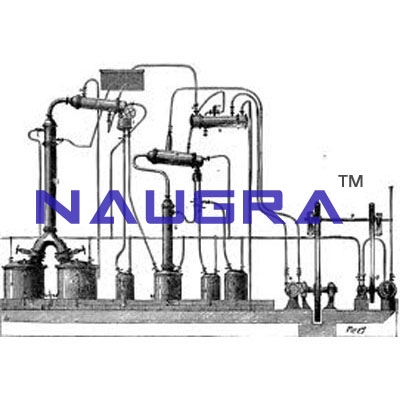- Civil Lab Mechanical Lab Engineering Lab Equipments
- sales@didacticlabequipments.com

CAT NO: DIDACTICNLE-Export-210061
Continuous Rectification- Engineering Lab Training Systems.
Technical Description
Distillation is used to
separate liquid mixtures made up of individual liquids that are soluble
in one another. Rectification refers to distillation in
a countercurrent. Ethanol/water is recommended as the liquid mixture for
the Distillation is used to separate liquid mixtures made up of
individual liquids that are soluble in one another. Rectification refers
to distillation in a countercurrent. Ethanol/water is recommended as
the liquid mixture for the Distillation is used to separate liquid
mixtures made up of individual liquids that are soluble in one another.
Rectification refers to distillation in a countercurrent. Ethanol/water
is recommended as the liquid mixture for the Continuous Rectification.
It is fed into the column. It partially evaporates on its way to the
bottom of the column where it is heated to boiling. The mixed vapour
produced then moves upwards in the column. The mixed vapour contains a
higher concentration of the component with the lower boiling point
(ethanol). It leaves the top of the column and is condensed using a
condenser and a phase separation tank. Part of this condensate is
collected in a tank as product while the rest is fed back into the
column. Here, on its way downwards, it undergoes further heating and
material exchange with the rising mixed vapour. This exchange causes the
vapour phase to become richer in ethanol and the liquid phase to become
richer in water. The liquid phase moves to the bottom and can be
collected in two tanks.
A heat exchanger allows the feed to
be preheated by the bottom product carried away from the column. A sieve
tray column and a packed column are available. The sieve tray column
has three connections at different heights for the feed. The packed
column is filled with Raschig rings. The reflux ratio is adjusted using
actuating valves.
Relevant experimental parameters are
recorded by sensors and displayed digitally and processed onto a PC. The
software also allows adjustment of the evaporator and the reflux ratio
using PID controllers.. It is fed into the column. It partially
evaporates on its way to the bottom of the column where it is heated to
boiling. The mixed vapour produced then moves upwards in the column. The
mixed vapour contains a higher concentration of the component with the
lower boiling point (ethanol). It leaves the top of the column and is
condensed using a condenser and a phase separation tank. Part of this
condensate is collected in a tank as product while the rest is fed back
into the column. Here, on its way downwards, it undergoes further
heating and material exchange with the rising mixed vapour. This
exchange causes the vapour phase to become richer in ethanol and the
liquid phase to become richer in water. The liquid phase moves to the
bottom and can be collected in two tanks.
A heat exchanger
allows the feed to be preheated by the bottom product carried away from
the column. A sieve tray column and a packed column are available. The
sieve tray column has three connections at different heights for the
feed. The packed column is filled with Raschig rings. The reflux ratio
is adjusted using actuating valves.
Relevant experimental
parameters are recorded by sensors and displayed digitally and processed
onto a PC. The software also allows adjustment of the evaporator and
the reflux ratio using PID controllers.. It is fed into the column.
It partially evaporates on its way to the bottom of the column where it
is heated to boiling. The mixed vapour produced then moves upwards in
the column. The mixed vapour contains a higher concentration of the
component with the lower boiling point (ethanol).
